Gabon is home to an impressive variety of birds, with more than 700 species that inhabit the lush rainforests and diverse ecosystems of this beautiful country.
From colorful parrots and toucans to majestic eagles and owls, these birds make up a vibrant part of the wildlife in Gabon. With its large range of habitats, from coastal wetlands to tropical forests, Gabon is an ideal place for birdwatching.
The country is also home to some of the rarest species of birds, such as the White-breasted Guineafowl, the Congo Serpent Eagle and the Black-Headed Weaver. This article will explore the incredible variety of birds found in Gabon and the best places to observe them.
1. Gabon Coucal
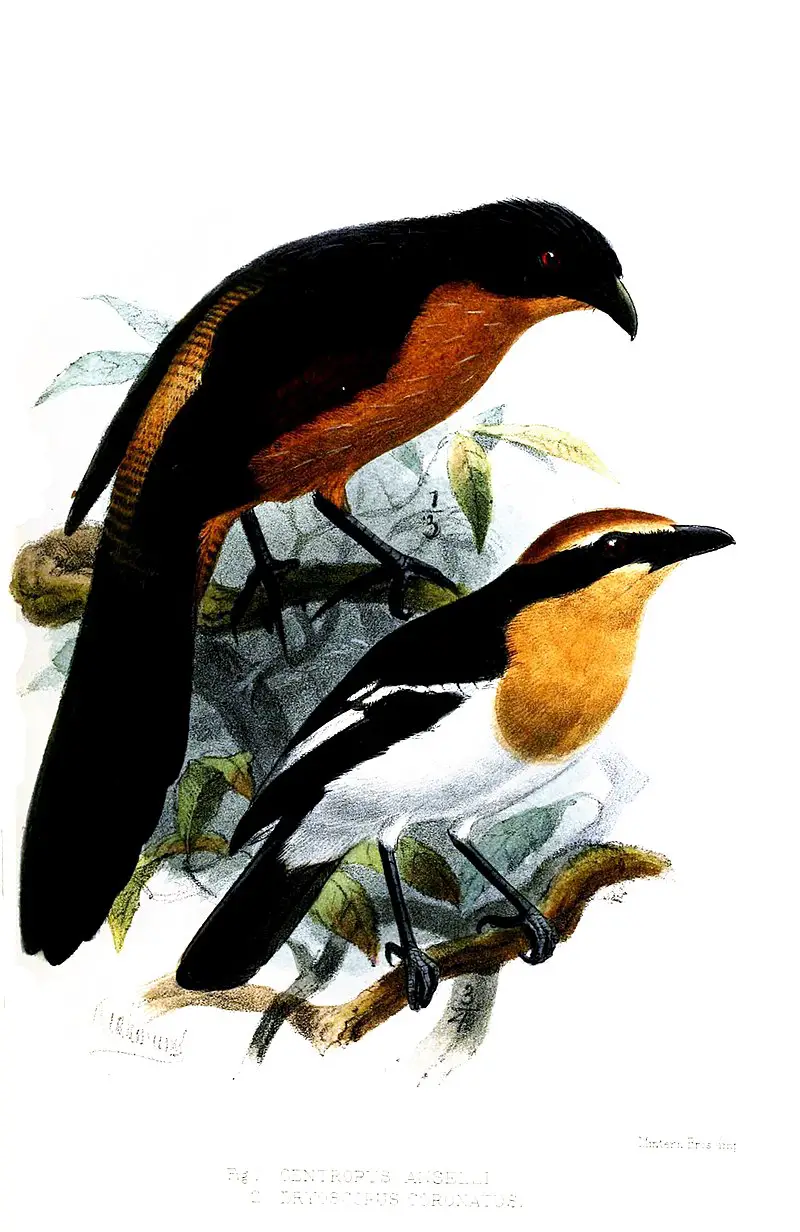
The Gabon coucal is a species of cuckoo found primarily in the country of Gabon and its neighboring regions. It has an average length between 46-58 cm, making it one of the larger members among its family Cuculidae.
Both male and female sexes have similar features with adults having dark brown head, neck and upper parts while their lower body tends to be lighter reddish-brown with white barring on breast and flanks.
These birds are usually seen singly or in pairs perching atop small trees or shrubs within forests near streams edges or clearings during day time hours looking out for prey like insects, lizards as well as smaller vertebrates such as frogs and rodents which they capture by dropping down from sky onto them quickly before flying away again.Scientific classification:
| Kingdom | Animalia |
| Phylum | Chordata |
| Class | Aves |
| Order | Cuculiformes |
| Family | Cuculidae |
| Genus | Centropus |
| Species | C. anselli |
2. Rosy Bee-Eater
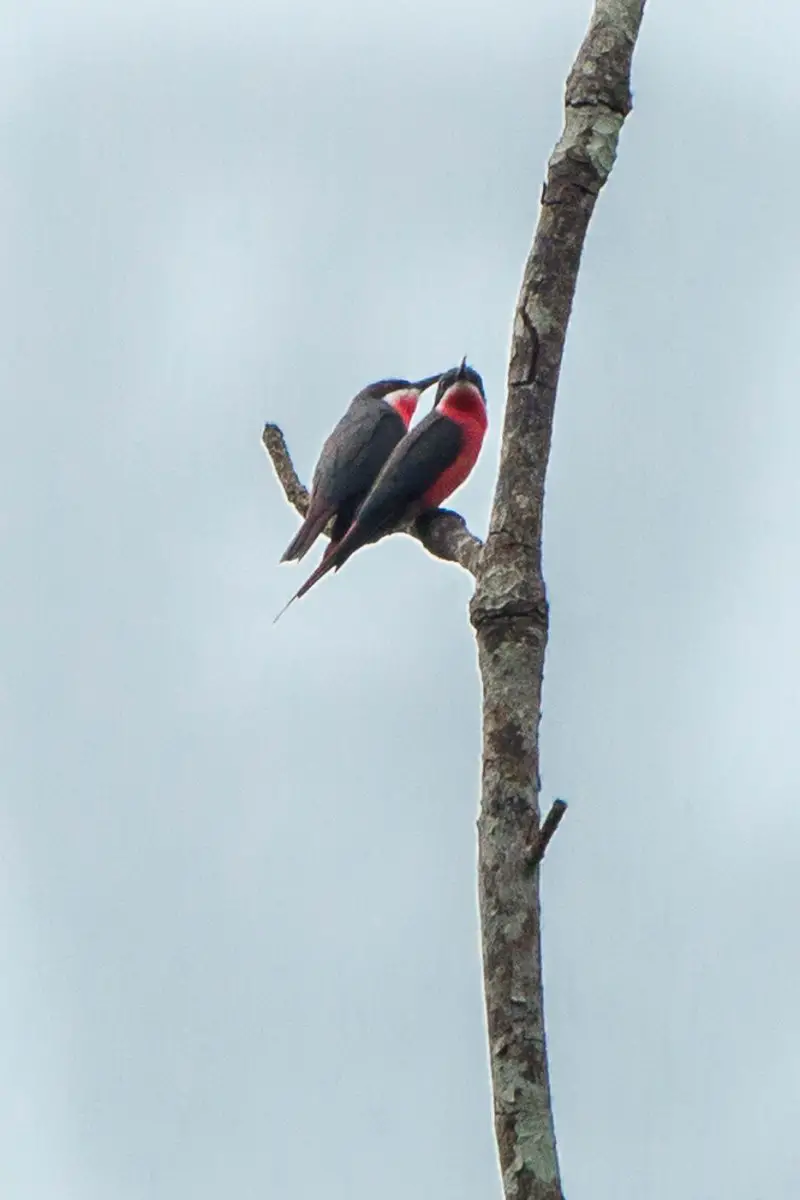
The Rosy Bee-Eater (Merops malimbicus) is a beautiful species of bird found in various parts of Africa. It was first described by English naturalist George Shaw in 1806 and its name originates from the type locality Malimbe, Cabinda.
This colorful bird has an eye-catching plumage consisting of rosy hues on its back and head with dark wings, tail feathers and belly area.
The bee-eater’s diet mainly consists of insects like bees, beetles, moths or dragonflies which it catches while flying over fields or open woodlands.
Some subspecies also eat small lizards or frogs and occasionally even baby birds.
These fascinating creatures are social animals that form colonies when breeding season begins making them a joy to watch for any nature enthusiast.Scientific classification:
| Kingdom | Animalia |
| Phylum | Chordata |
| Class | Aves |
| Order | Coraciiformes |
| Family | Meropidae |
| Genus | Merops |
| Species | M. malimbicus |
3. Grey-Necked Rockfowl
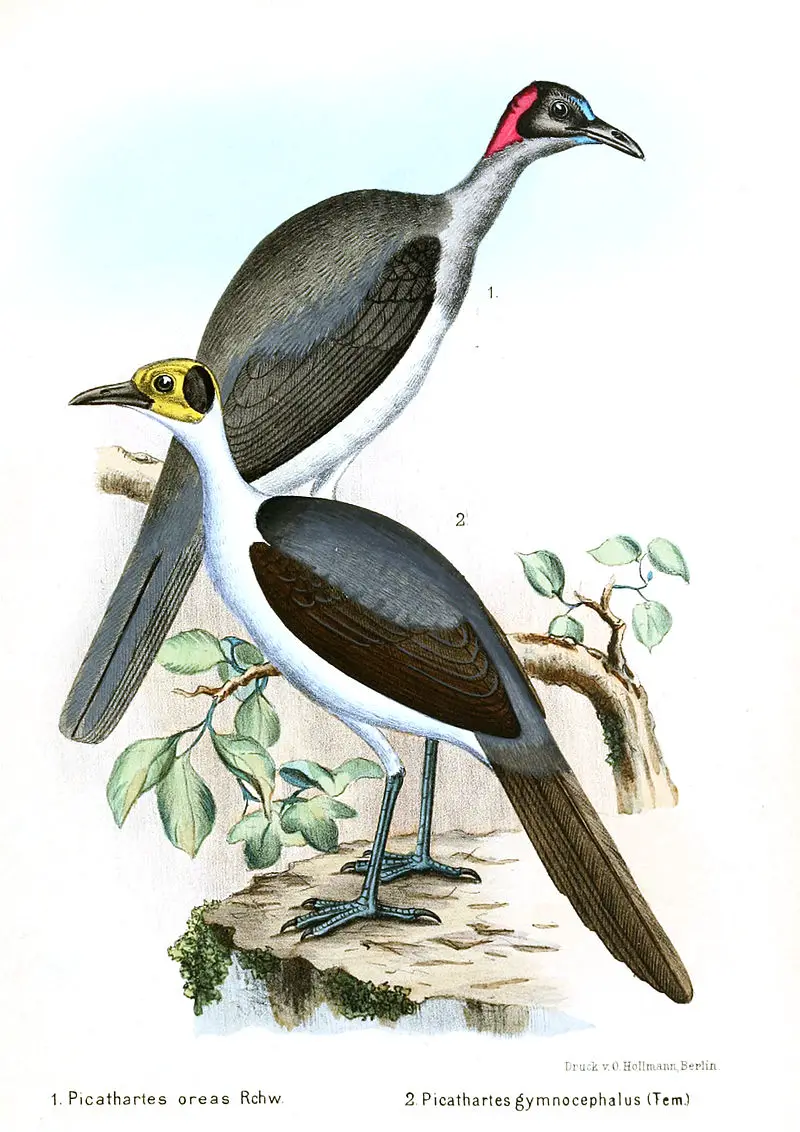
The Grey-necked Rockfowl is a magnificent bird found in rocky areas of close-canopied rainforest from south-west Nigeria to Cameroon, Equatorial Guinea and Gabon.
On the island of Bioko it can also be seen. It has an unmistakable look with its long neck and tail, grey upperparts contrasted with white underparts that give it a remarkable appearance.
It usually feeds on insects, lizards, small mammals as well as fruits while hopping nervously around rocks or perching atop them searching for food items.
Its population appears threatened due to habitat destruction caused by human activities such as logging and mining which have reduced suitable nesting sites amongst other factors like predation by cats or snakes etcetera.
Thus conservation efforts should be made so we don’t lose this species forever.Scientific classification:
| Kingdom | Animalia |
| Phylum | Chordata |
| Class | Aves |
| Order | Passeriformes |
| Family | Picathartidae |
| Genus | Picathartes |
| Species | P. oreas |
4. Woodland Kingfisher
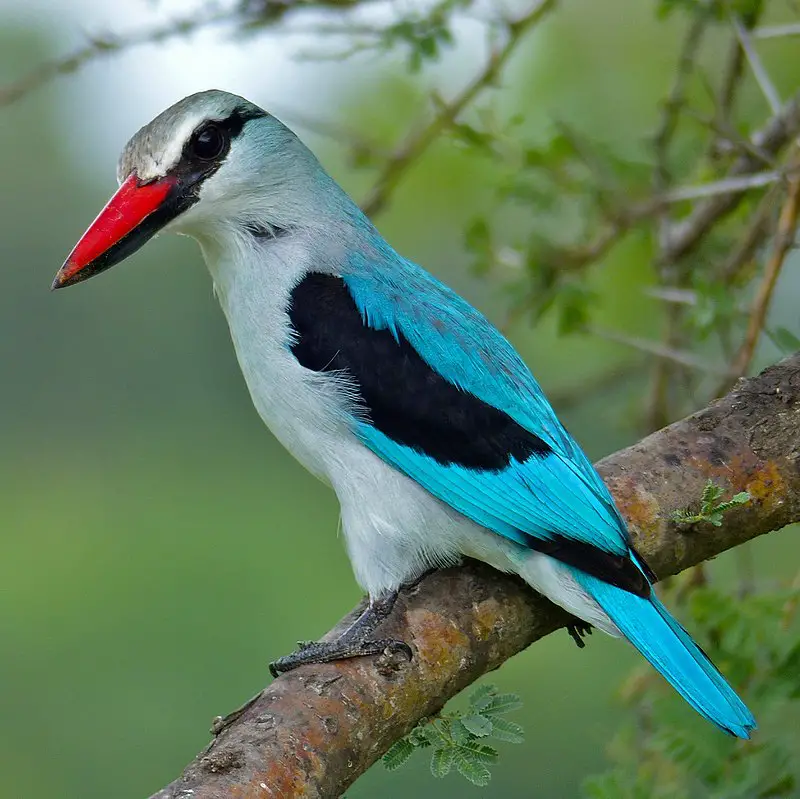
The Woodland Kingfisher is a beautiful bird, native to Africa south of the Sahara. It was first described in 1766 by Carl Linnaeus who called it Alcedo senegalensis.
This tree kingfisher has an attractive blue and white plumage with some red and black markings on its wings, tail and head.
The male also has a bright orange beak which helps to distinguish him from the female whose beak is yellowish-green.
These birds can usually be found in wooded areas near water sources such as rivers or lakes where they hunt for food including fish, frogs, small insects and even lizards.
They build their nests either high up in trees or inside holes dug out of banks near rivers and ponds.
Although not threatened yet, these lovely creatures need our protection so that future generations will have the chance to marvel at them too.Scientific classification:
| Kingdom | Animalia |
| Phylum | Chordata |
| Class | Aves |
| Order | Coraciiformes |
| Family | Alcedinidae |
| Subfamily | Halcyoninae |
| Genus | Halcyon |
| Species | H. senegalensis |
5. Blue-Breasted Kingfisher
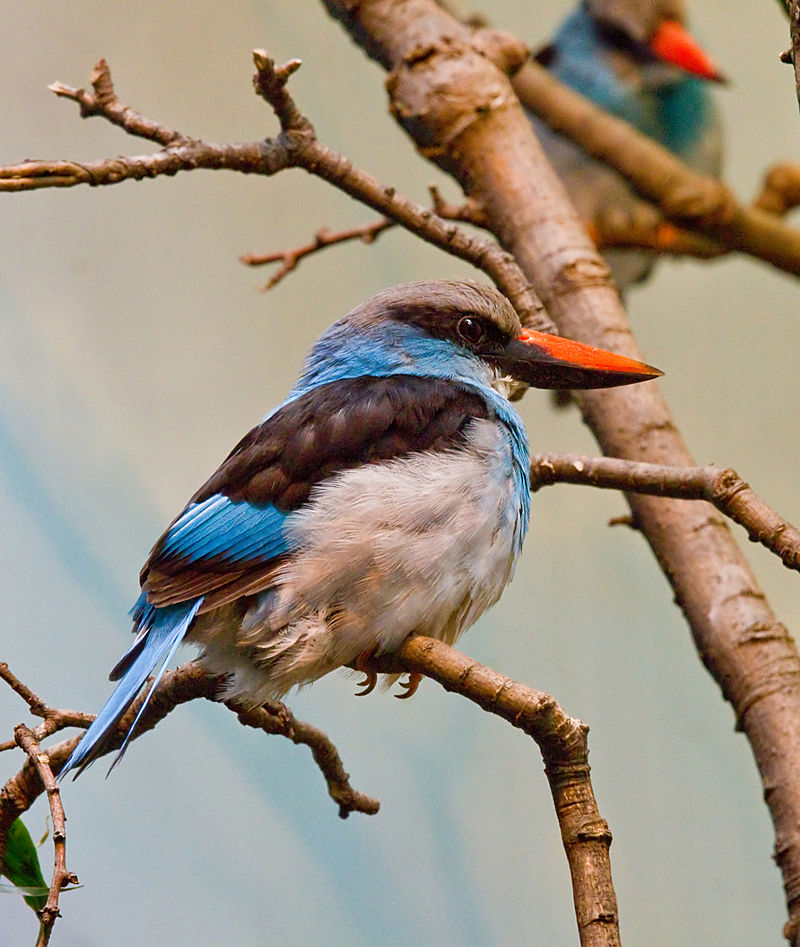
The Blue-breasted Kingfisher is a striking species of bird native to Equatorial Africa. Measuring 25 cm in length, this tree kingfisher has bright blue feathers on its head, back, wings and tail.
Its underparts are white with a contrasting blue breast band for added visual interest.
Though essentially resident there, it does migrate from drier savannas to wetter habitats during the dry season in order to survive better.
This species feeds mainly on insects such as beetles and grasshoppers but will also take small fish when available near the shorelines or riverside vegetation they inhabit.
The beautiful song of these birds can often be heard echoing through their natural environment – an unmistakable sound that makes them easily recognizable.Scientific classification:
| Kingdom | Animalia |
| Phylum | Chordata |
| Class | Aves |
| Order | Coraciiformes |
| Family | Alcedinidae |
| Subfamily | Halcyoninae |
| Genus | Halcyon |
| Species | H. malimbica |
6. Red-Billed Dwarf Hornbill
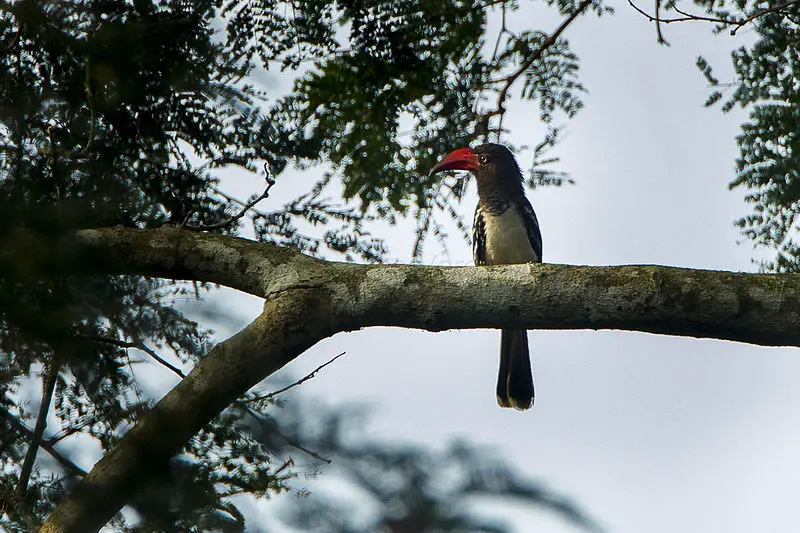
The red-billed dwarf hornbill is a species of bird found in the African tropical rainforest. It belongs to the Bucerotidae family and has a striking appearance, with its bright red bill contrasting against mainly black feathers.
Its wings are long and pointed, helping it to fly through dense vegetation quickly. The diet of this small hornbill consists mostly of insects, fruit and seeds.
They live both solitarily or in pairs but may form larger flocks during breeding season when they search for mates together.
These birds build their nests high up into tree hollows where they lay their eggs before taking turns incubating them until hatching occurs – an amazing example of teamwork.
Red-billed dwarf hornbills really are remarkable creatures that help keep natural ecosystems balanced throughout Africa’s lush forests; we should all do our part in protecting these majestic animals from extinction so future generations can appreciate them too.Scientific classification:
| Kingdom | Animalia |
| Phylum | Chordata |
| Class | Aves |
| Order | Bucerotiformes |
| Family | Bucerotidae |
| Genus | Lophoceros |
| Species | L. camurus |
7. Blue-Breasted Bee-Eater
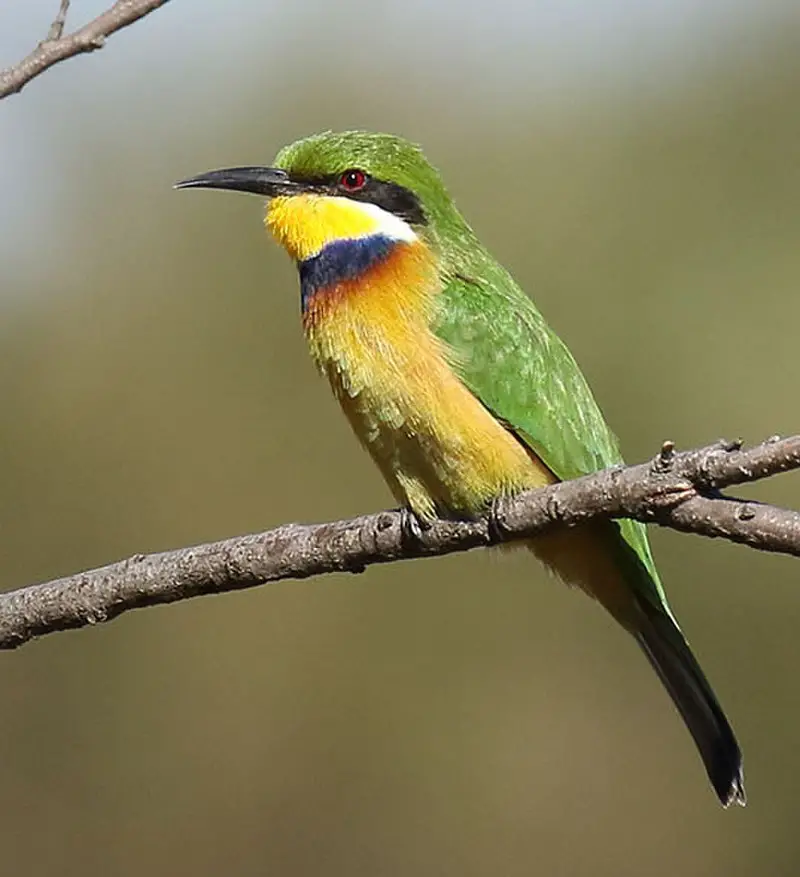
The Blue-breasted Bee-eater (Merops variegatus) is a truly magnificent species of bird found in Central Africa. It belongs to the family Meropidae, which also includes other visually similar birds with specialized diets consisting mainly of Hymenopterans.
This fascinating bird has bright plumage and stands out among its peers due to its large head, short neck and long curved slender beak that allow it to feed on bees and other insects.
Its wings are well developed for strong flight capabilities while its tail helps maintain balance during high speed chases after prey.
The blue-breasted bee-eater is an incredibly beautiful species worth protecting as they play an important role in their natural environment by controlling insect populations.Scientific classification:
| Kingdom | Animalia |
| Phylum | Chordata |
| Class | Aves |
| Order | Coraciiformes |
| Family | Meropidae |
| Genus | Merops |
| Species | M. variegatus |
8. Black-Headed Bee-Eater
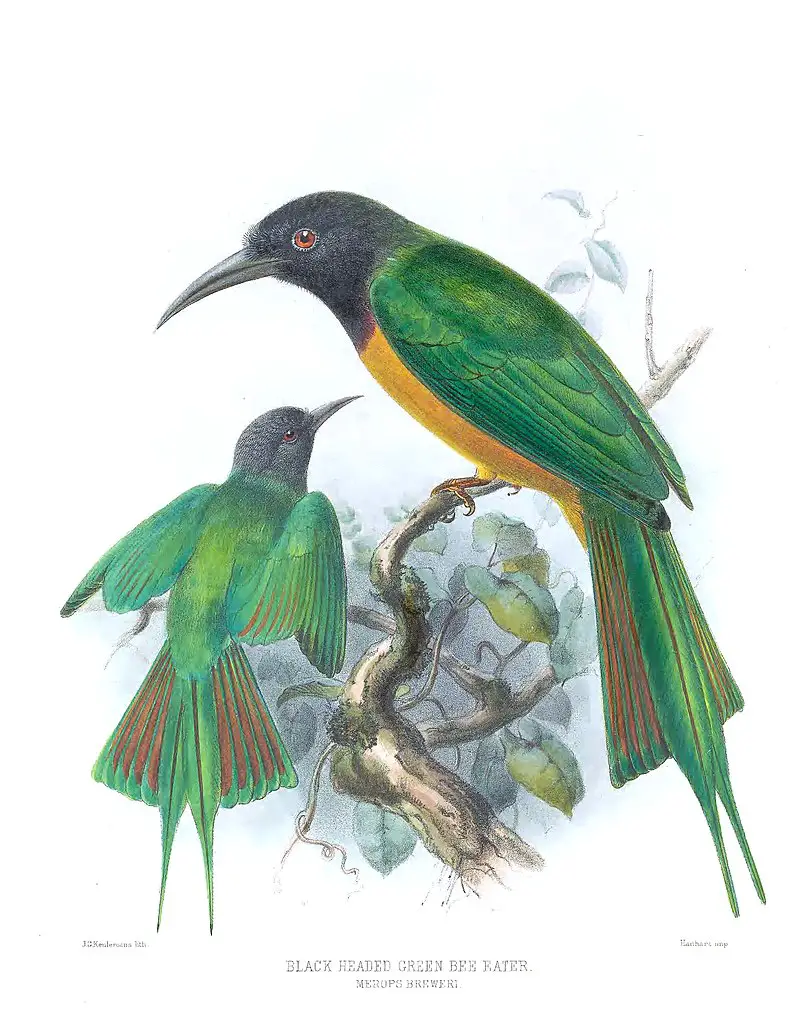
The Black-headed Bee-eater is a beautiful bird found in the tropical forests of Central and West Africa. It belongs to the family Meropidae and its length ranges between 25 – 28 cm (10 – 11 inches).
The most remarkable feature of this species is its black head which contrasts with the bright yellow upperparts, green wings and white belly.
Its diet consists mainly of insects, especially bees. This species perches on branches or wires while looking for food in midair before diving down towards it’s target.
The Black-headed Bee-eaters are also known for their loud calls that echo through their habitat during breeding season as they become more active during this time.
Despite being widespread across much of Africa, these birds remain vulnerable due to deforestation, hunting pressure from humans and natural predators such as hawks preying upon them.Scientific classification:
| Kingdom | Animalia |
| Phylum | Chordata |
| Class | Aves |
| Order | Coraciiformes |
| Family | Meropidae |
| Genus | Merops |
| Species | M. breweri |
9. African Pied Hornbill
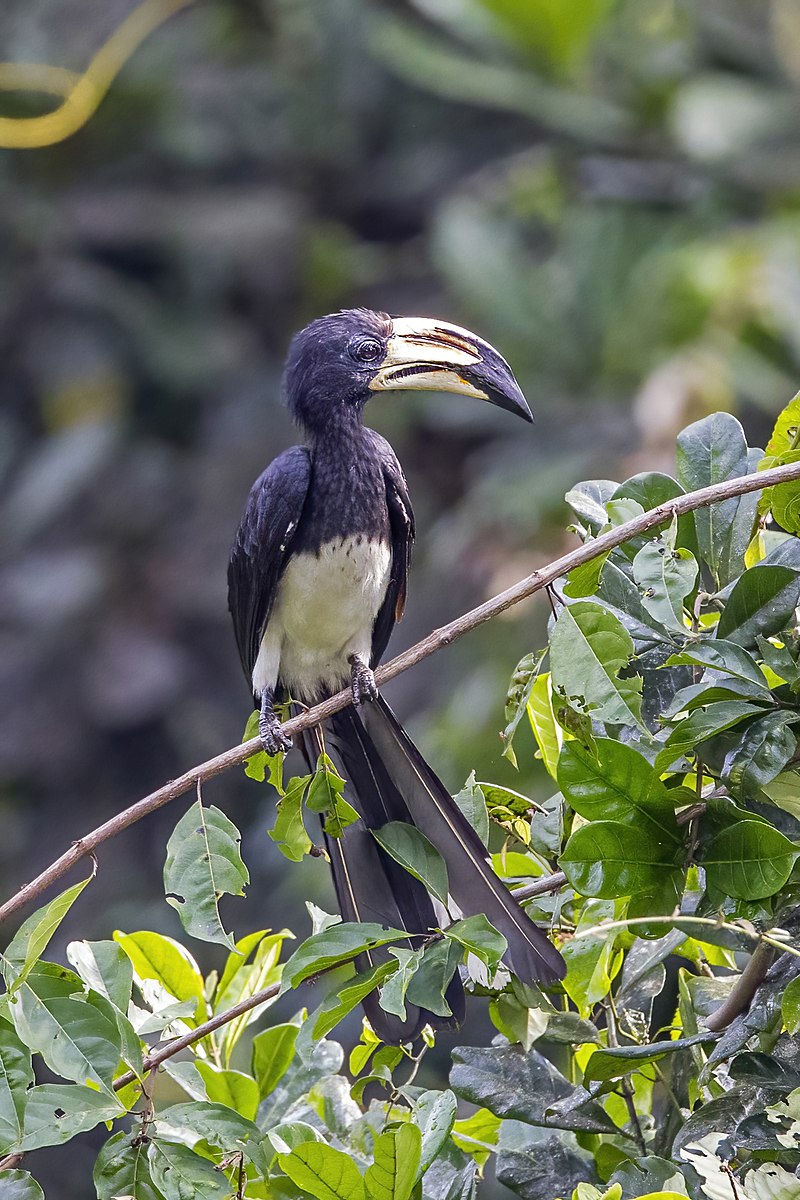
The African pied hornbill is a beautiful bird belonging to the family of tropical near-passerine birds found in the Old World.
It is widely distributed across equatorial Africa, ranging from The Gambia to western Uganda and northern Angola.
This species prefers habitats with plenty of trees for it to nestle in and make its home.
When breeding season arrives, females lay up to four white eggs inside tree holes that are sealed off by the males using mud or other materials as part of their nesting ritual.
These magnificent creatures have distinctive features such as black feathers on their bodies contrasted against bright yellow eyes and strikingly long beaks which they use mainly for eating fruit but also insects too.
They are an important part of African ecosystems and should be protected at all costs so future generations can continue appreciating these majestic birds.Scientific classification:
| Kingdom | Animalia |
| Phylum | Chordata |
| Class | Aves |
| Order | Bucerotiformes |
| Family | Bucerotidae |
| Genus | Lophoceros |
| Species | L. fasciatus |
10. Gabon Woodpecker
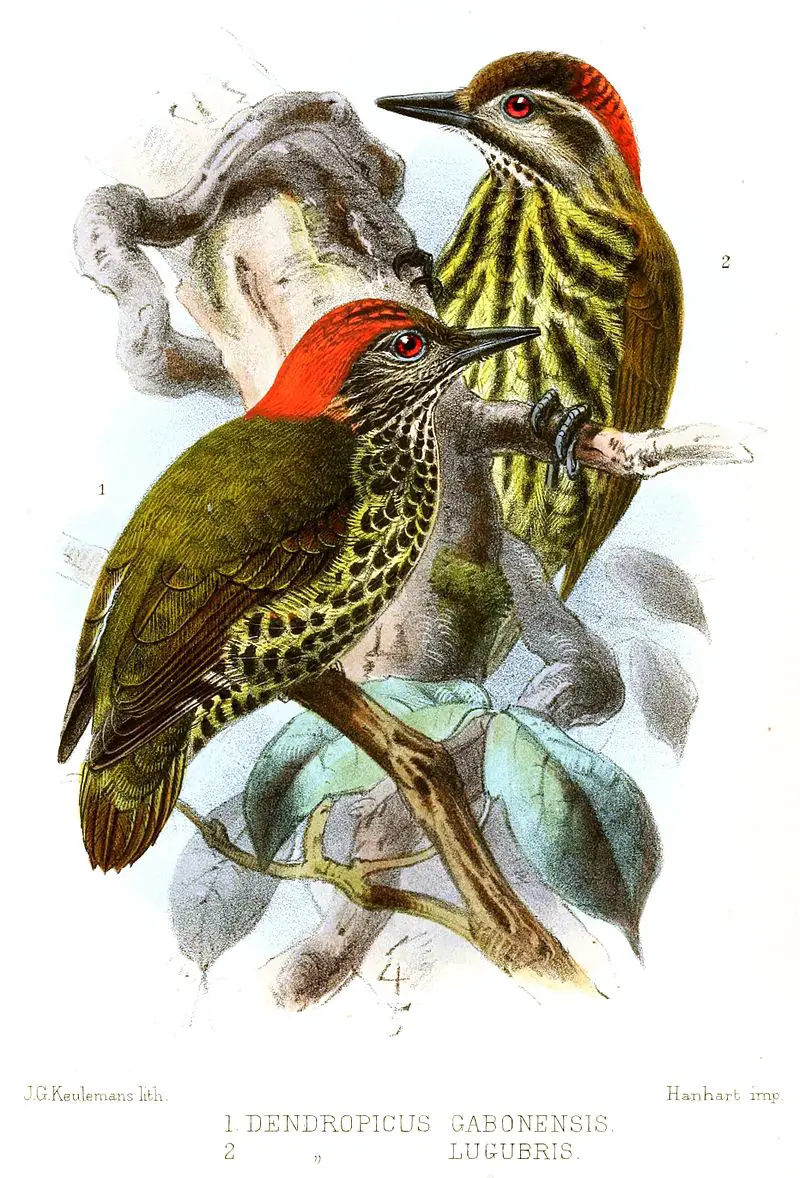
The Gabon woodpecker is a small species of bird found in western central Africa.
It has plain green upperparts, a plain dark tail and heavily spotted underparts with yellowish background colour.
The crown is brownish but the males have red feathers adorning their head giving them an eye-catching look.
Its bill is short and broad at the base for supporting its diet which mainly consists of insects such as ants and beetles.
This beautiful bird also likes to eat fruits like figs when available near its habitat in woodland areas or savannahs often near rivers or streams where it can find food easily on trees during its search for prey.Scientific classification:
| Kingdom | Animalia |
| Phylum | Chordata |
| Class | Aves |
| Order | Piciformes |
| Family | Picidae |
| Genus | Dendropicos |
| Species | D. gabonensis |
11. Black-Casqued Hornbill
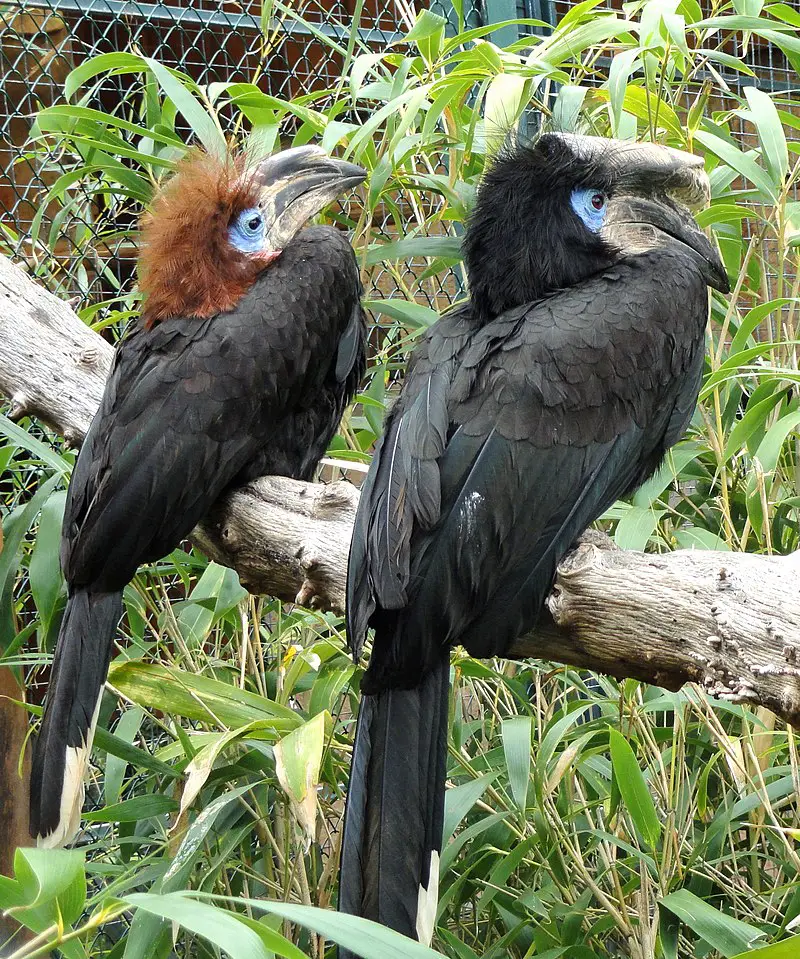
The black-casqued hornbill is a species of bird in the Bucerotidae family, often found across African tropical rainforest.
It has distinctive black casques on its beak and wattles on its throat which gives it an eye-catching appearance.
As with all Hornbills, they have large bills and strong legs for flying long distances to find food – usually insects such as beetles or caterpillars.
They also enjoy eating fruit when they can find them.
The Black-Casqued Wattled Hornbill typically lives alone but during mating season will form small groups consisting of two females and one male; these birds are monogamous so the same couple stay together throughout their life cycle.Scientific classification:
| Kingdom | Animalia |
| Phylum | Chordata |
| Class | Aves |
| Order | Bucerotiformes |
| Family | Bucerotidae |
| Genus | Ceratogymna |
| Species | C. atrata |
12. Vieillot’s Black Weaver
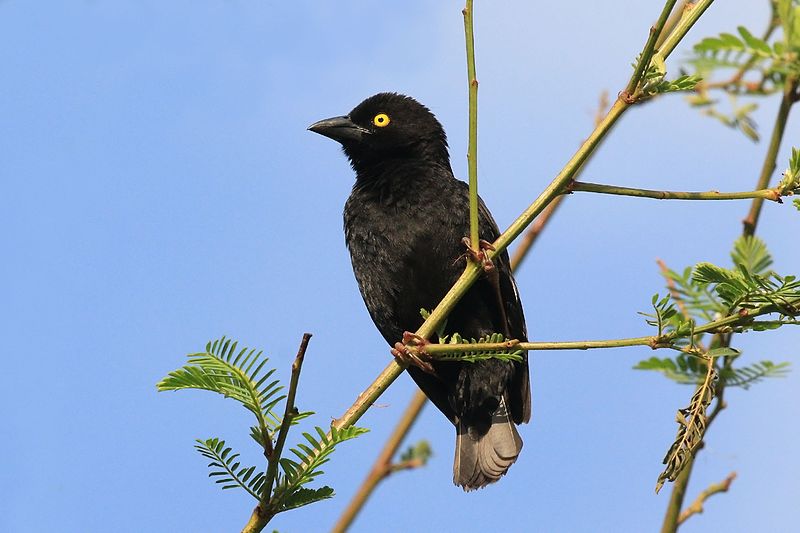
Vieillot’s black weaver is a species of bird in the family Ploceidae, named after French ornithologist Louis Jean Pierre Vieillot.
This beautiful bird can be found living in western and central Africa in its natural habitat of subtropical or tropical dry forests.
The males are easily identified by their chestnut-brown head, back and wings with a glossy black tail and orangey-yellow bill.
They will often gather together to make nests from strands of grass that hang down from trees like hammocks.
These birds feed on seeds and insects which they find along riverbanks during the wet season when food sources are most abundant.
All in all, these stunning birds add much beauty to African landscapes while being an important part of the local ecology.Scientific classification:
| Kingdom | Animalia |
| Phylum | Chordata |
| Class | Aves |
| Order | Passeriformes |
| Family | Ploceidae |
| Genus | Ploceus |
| Species | P. nigerrimus |